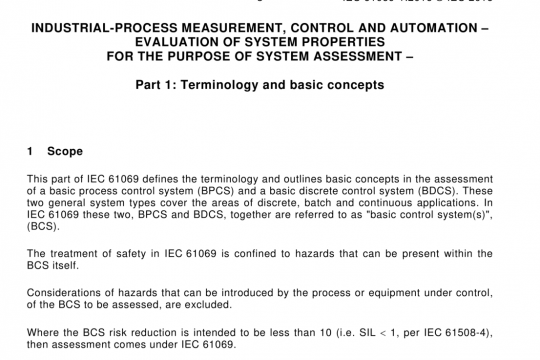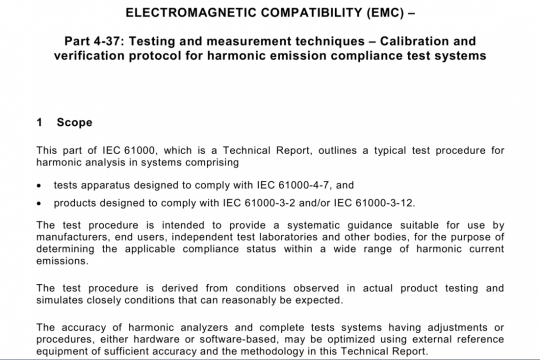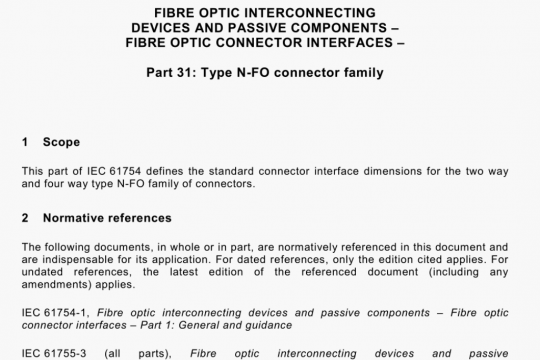IEC 61207-3 pdf free download
IEC 61207-3 pdf free download.Gas analyzers – Expression of performance – Part 3: Paramagnetic oxygen analyzers.
4.2.2.3 Rated range of calibration and reference gas flow
Calibration and reference gas flow shall be within the rated range of sample flow for the analyzer. For minimum uncertainties, the calibration gas flow should be set the same as the sample flow. Excessively high calibration and reference gas flows can damage the paramagnetic sensor, particularly from a large pressure impulse, which may occur if the flow outlet becomes blocked and then quickly released.
4.3 Additional characteristics related to specification of performance
4.3.1 The following additional characteristics to those detailed in IEC 61207-1 may be required to be specified to define the performance of a paramagnetic analyzer or its suitability for a particular application. Depending on the analyzer design details or application, some of these additional terms may be omitted.
4.3.2 Hazardous classification of the area in which the analyzer is to be located. General purpose analyzers will not be suitable for location in hazardous areas.
4.3.3 Flammable gases or vapours should only be sampled by analyzers which are specified as suitable and should be vented from the analyzer in a safe manner.
4.3.4 If the sample gas is toxic, this should be specified, as special maintenance instructions may be required to ensure leak-free operation. Installation of the analyzer shall also take into account how the sample gas is vented, returned to process, or otherwise dealt with.
4.3.5 The orientation of the analyzer should be considered. In fixed installations, analyzers should be positioned in an upright manner so that any uncertainties due to tilt are minimized. For installations that move (for example, ships), the rated range of tilt should be specified.
4.3.6 The vibration sensitivity of the analyzer should be considered. For applications where the vibration levels are outside the rated range of the analyzer, anti-vibration mountings are recommended.
4.3.7 The response time of the analyzer and its sampling system should be considered. The response time specified for the analyzer will usually be considerably less than the sampling system, but is dependent on the sampling system design.
NOTE Some paramagnetic analyzers are designed with adjustable sample flow and bypass flow sample systems.
4.4 Important aspects related to specification of performance
4.4.1 General
Although covered in IEC 61207-1, the following aspects are particularly relevant to paramagnetic analyzers.
4.4.2 Rated range of ambient temperature
The performance of an analyzer is normally ambient temperature-dependent and will have a defined operating range of temperatures within which it will operate within its specification.
4.4.5 Rated range of sample pressure
If the sample is returned to the process stream (assuming process pressure is within the rated range of sample pressure), variations in process pressure will cause similar uncertainties to those described in 4.4.4.
Sample pressure compensation is usually offered by manufacturers of process analyzers so that this type of uncertainty is minimized.
4.4.6 Rated range of sample flow
Uncertainties in indicated value due to sample flow can be minimized by setting the
calibration flow rates to the expected sample flow rates.
4.4.7 Rated range of sample dew point
Samples shall be supplied within the rated range of the sample dew point to increase performance reliability. Also, differences in indicated value will occur if the measurement is made on a wet basis compared to a dry basis.
NOTE 1 If the rated range of sample dew point for an analyzer is low, then the sampling system can have to remove water vapour from the sample. If, for example, 10 % water vapour were removed by the sample system, the corresponding indicated oxygen value would be 100/90 times greater than the value in the wet sample.
NOTE 2 Some oxygen analyzers are designed so that the sensor is controlled at temperatures within the range
333.15 K to 393,15 K (60 °C to 120 °C). This will enable relatively wet samples to be analyzed reliably. For example, a sample saturated with water vapour at 294.15 K (21 °C) contains approximately 2,5 % water vapour. This wet sample would normally be within the rated range of the sample dew point for an analyzer wherein the sensor is controlled at 333,15 K (60 °C). However, the water content in the sample will produce a volumetric error compared to a measurement made on a dry basis where the water has been removed prior to measurement.IEC 61207-3 pdf download.




